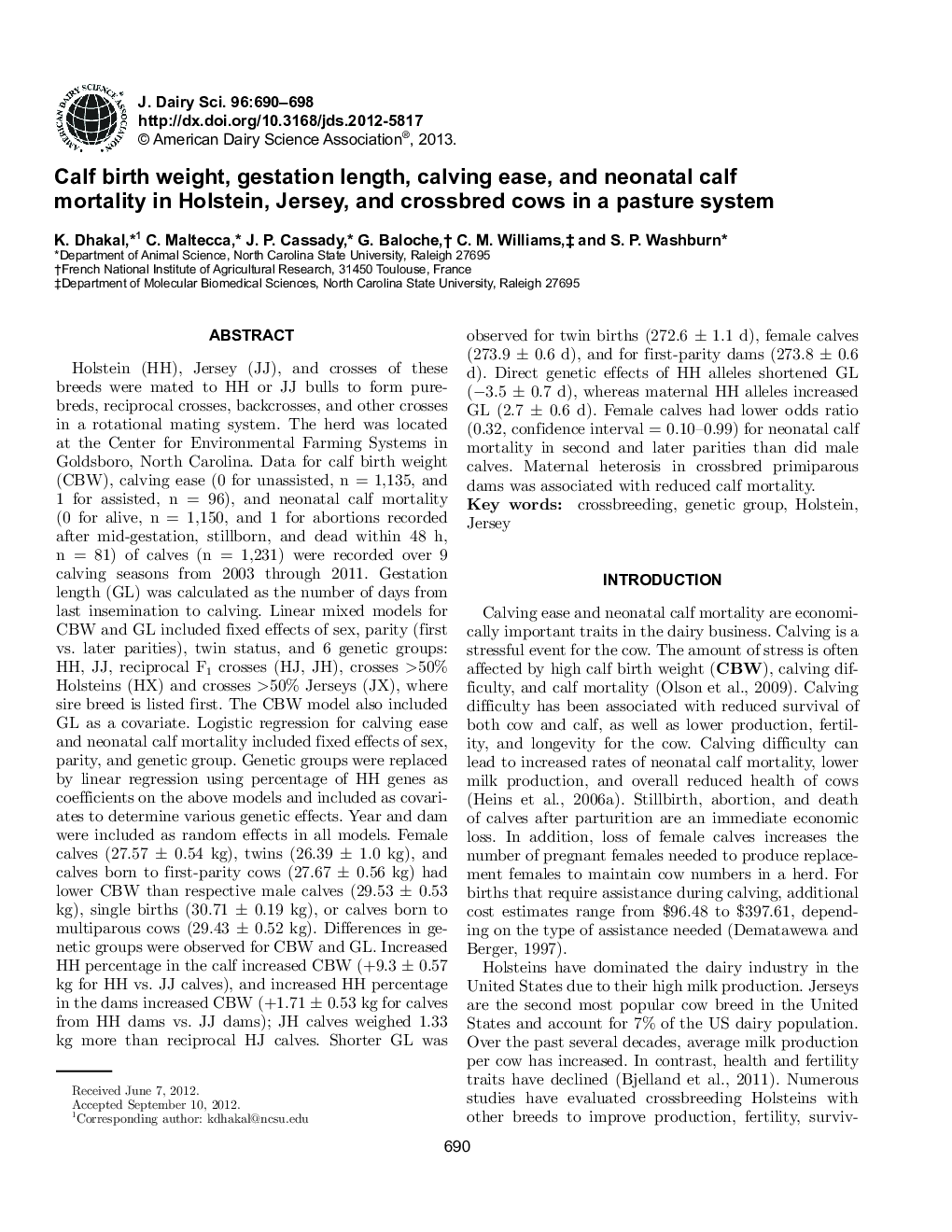| کد مقاله | کد نشریه | سال انتشار | مقاله انگلیسی | نسخه تمام متن |
|---|---|---|---|---|
| 10980655 | 1108071 | 2013 | 9 صفحه PDF | دانلود رایگان |
عنوان انگلیسی مقاله ISI
Calf birth weight, gestation length, calving ease, and neonatal calf mortality in Holstein, Jersey, and crossbred cows in a pasture system
ترجمه فارسی عنوان
وزن تولد نوزاد، طول بارداری، آسایش زایمان و مرگ و میر گوساله نوزاد در هولشتاین، جرسی و گاوهای کراس برده در یک سیستم مرتع
دانلود مقاله + سفارش ترجمه
دانلود مقاله ISI انگلیسی
رایگان برای ایرانیان
کلمات کلیدی
موضوعات مرتبط
علوم زیستی و بیوفناوری
علوم کشاورزی و بیولوژیک
علوم دامی و جانورشناسی
چکیده انگلیسی
Holstein (HH), Jersey (JJ), and crosses of these breeds were mated to HH or JJ bulls to form purebreds, reciprocal crosses, backcrosses, and other crosses in a rotational mating system. The herd was located at the Center for Environmental Farming Systems in Goldsboro, North Carolina. Data for calf birth weight (CBW), calving ease (0 for unassisted, n = 1,135, and 1 for assisted, n = 96), and neonatal calf mortality (0 for alive, n = 1,150, and 1 for abortions recorded after mid-gestation, stillborn, and dead within 48 h, n = 81) of calves (n = 1,231) were recorded over 9 calving seasons from 2003 through 2011. Gestation length (GL) was calculated as the number of days from last insemination to calving. Linear mixed models for CBW and GL included fixed effects of sex, parity (first vs. later parities), twin status, and 6 genetic groups: HH, JJ, reciprocal F1 crosses (HJ, JH), crosses >50% Holsteins (HX) and crosses >50% Jerseys (JX), where sire breed is listed first. The CBW model also included GL as a covariate. Logistic regression for calving ease and neonatal calf mortality included fixed effects of sex, parity, and genetic group. Genetic groups were replaced by linear regression using percentage of HH genes as coefficients on the above models and included as covariates to determine various genetic effects. Year and dam were included as random effects in all models. Female calves (27.57 ± 0.54 kg), twins (26.39 ± 1.0 kg), and calves born to first-parity cows (27.67 ± 0.56 kg) had lower CBW than respective male calves (29.53 ± 0.53 kg), single births (30.71 ± 0.19 kg), or calves born to multiparous cows (29.43 ± 0.52 kg). Differences in genetic groups were observed for CBW and GL. Increased HH percentage in the calf increased CBW (+9.3 ± 0.57 kg for HH vs. JJ calves), and increased HH percentage in the dams increased CBW (+1.71 ± 0.53 kg for calves from HH dams vs. JJ dams); JH calves weighed 1.33 kg more than reciprocal HJ calves. Shorter GL was observed for twin births (272.6 ± 1.1 d), female calves (273.9 ± 0.6 d), and for first-parity dams (273.8 ± 0.6 d). Direct genetic effects of HH alleles shortened GL (â3.5 ± 0.7 d), whereas maternal HH alleles increased GL (2.7 ± 0.6 d). Female calves had lower odds ratio (0.32, confidence interval = 0.10-0.99) for neonatal calf mortality in second and later parities than did male calves. Maternal heterosis in crossbred primiparous dams was associated with reduced calf mortality.
ناشر
Database: Elsevier - ScienceDirect (ساینس دایرکت)
Journal: Journal of Dairy Science - Volume 96, Issue 1, January 2013, Pages 690-698
Journal: Journal of Dairy Science - Volume 96, Issue 1, January 2013, Pages 690-698
نویسندگان
K. Dhakal, C. Maltecca, J.P. Cassady, G. Baloche, C.M. Williams, S.P. Washburn,
